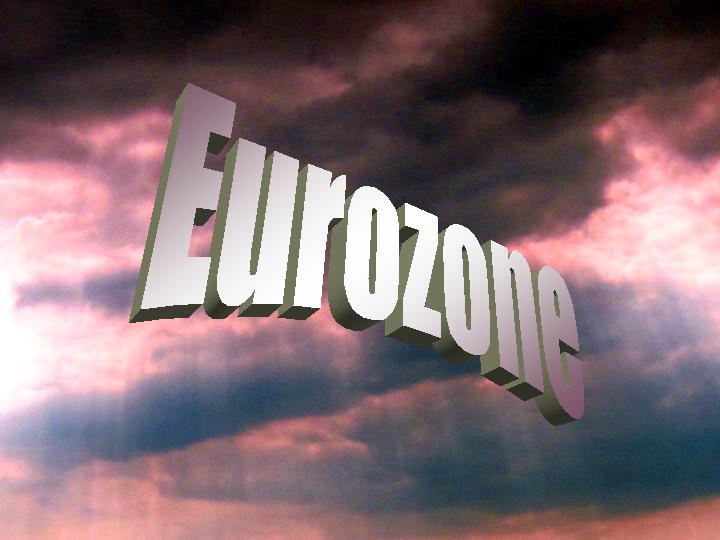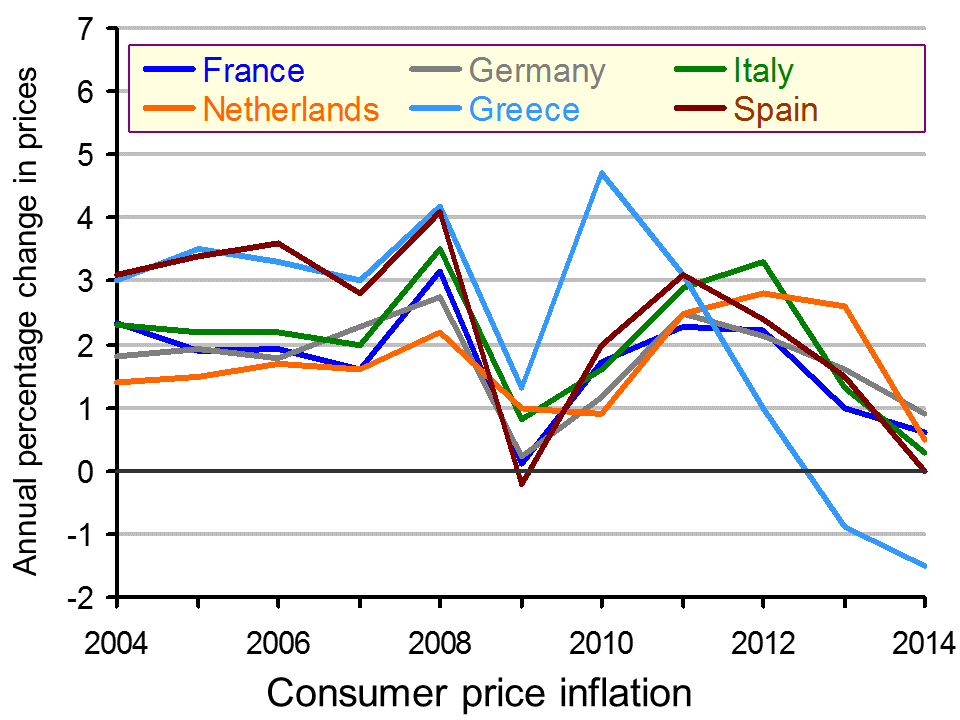Eurozone deflation risk
 The eurozone is made up of 18 countries (19 in January) and, besides sharing a common currency, they also seem to be sharing the trait of weak economic performance. The key macroeconomic variables across the eurozone nations have all seemingly been moving in the wrong direction and this is causing a lot of concern for policy-makers.
The eurozone is made up of 18 countries (19 in January) and, besides sharing a common currency, they also seem to be sharing the trait of weak economic performance. The key macroeconomic variables across the eurozone nations have all seemingly been moving in the wrong direction and this is causing a lot of concern for policy-makers.
Some of the biggest players in the eurozone have seen economic growth on the down-turn, unemployment rising and consumer and business confidence falling once again. Germany’s economic growth has been revised down and in Italy, unemployment rose to a record of 13.2% in September and around 25% of the workforce remains out of work in Spain and Greece. A significant consequence of the sluggish growth across this 18-nation bloc of countries is the growing risk of deflation.
 Whilst low and stable inflation is a macroeconomic objective across nations, there is such a thing as inflation that is too low. When inflation approaches 0%, the spectre of deflation looms large (see the blog post Deflation danger). The problem of deflation is that when people expect prices to fall, they stop spending. As such, consumption falls and this puts downward pressure on aggregate demand. After all, if you think prices will be lower next week, then you are likely to wait until next week. This decision by consumers will cause aggregate demand to shift to the left, thus pushing national income down, creating higher unemployment. If this expectation continues, then so will the inward shifts in AD. This is the problem facing the eurozone. In November, the inflation rate fell to 0.3%. One of the key causes is falling energy prices – normally good news, but not if inflation is already too low.
Whilst low and stable inflation is a macroeconomic objective across nations, there is such a thing as inflation that is too low. When inflation approaches 0%, the spectre of deflation looms large (see the blog post Deflation danger). The problem of deflation is that when people expect prices to fall, they stop spending. As such, consumption falls and this puts downward pressure on aggregate demand. After all, if you think prices will be lower next week, then you are likely to wait until next week. This decision by consumers will cause aggregate demand to shift to the left, thus pushing national income down, creating higher unemployment. If this expectation continues, then so will the inward shifts in AD. This is the problem facing the eurozone. In November, the inflation rate fell to 0.3%. One of the key causes is falling energy prices – normally good news, but not if inflation is already too low.
 Jonathan Loynes, Chief European Economist at Capital Economics said:
Jonathan Loynes, Chief European Economist at Capital Economics said:
“[the inflation and jobless data] gives the ECB yet another nudge to take urgent further action to revive the recovery and tackle the threat of deflation…We now expect the headline inflation rate to drop below zero at least briefly over the next six months and there is a clear danger of a more prolonged bout of falling prices.”
Some may see the lower prices as a positive change, with less household income being needed to buy the same basket of goods. However, the key question will be whether such low prices are seen as a temporary change or an indication of a longer-term trend. The answer to the question will have a significant effect on business decisions about investment and on the next steps to be taken by the ECB. It also has big consequences for other countries, in particular the UK. The data over the coming months across a range of macroeconomic variables may tell us a lot about what is to come throughout 2015. The following articles consider the eurozone data.
Euro area annual inflation down to 0.3% EuroStat News Release (28/11/14)
Eurozone inflation weakens again, adding pressure on ECB Nasdaq, Brian Blackstone (28/11/14)
Eurozone inflation rate falls in October BBC News (28/11/14)
Eurozone recovery fears weigh on UK plc, says report Financial Times, Alison Smith (30/11/14)
€300bn Jean-Claude Juncker Eurozone kickstarter sounds too good to be true The Guardian, Larry Elliott (26/11/14)
Eurozone area may be in ‘persistent stagnation trap’ says OECD BBC News (25/11/14)
Euro area ‘major risk to world growth’: OECD CNBC, Katy Barnato (25/11/14)
OECD sees gradual world recovery, urges ECB to do more Reuters, Ingrid Melander (25/11/14)
Questions
- What is deflation and why is it such a concern?
- Illustrate the impact of falling consumer demand in an AD/AS diagram.
- What policies are available to the ECB to tackle the problem of deflation? How successful are they likely to be and which factors will determine this?
- To what extent is the economic stagnation in the Eurozone a cause for concern to countries such as the UK and US? Explain your answer.
- How effective would quantitative easing be in combating the problem of deflation?